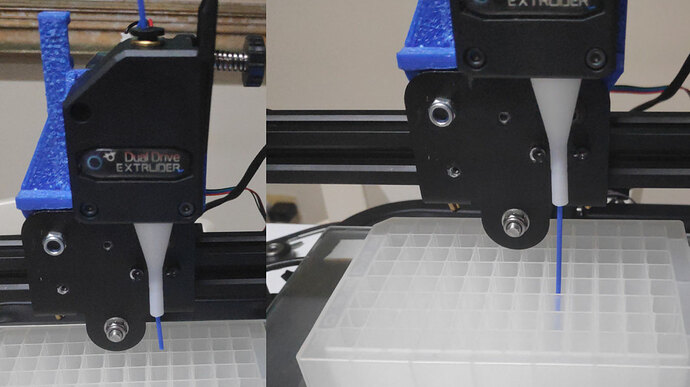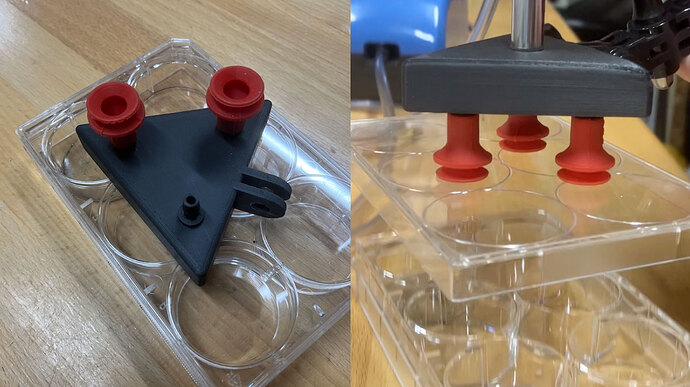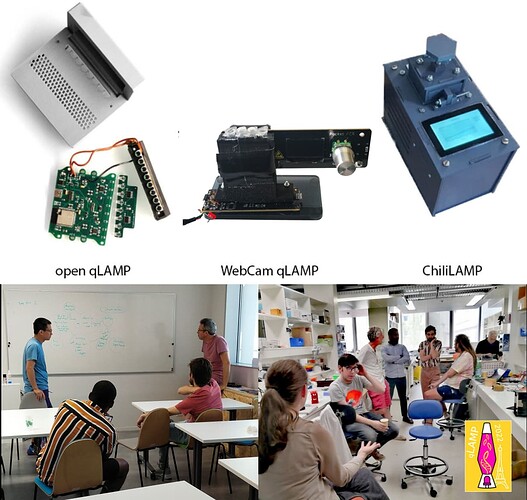GOSH 2022 Collaborative Development Program (GOSH CDP) - Phase 2
Hi, everyone! ![]() Welcome to GOSH CDP - Phase 2! Due to some unforeseen circumstances, we had to push back the start of the second phase later than expected. We are officially open to applications for the second phase of the collaborative development program.
Welcome to GOSH CDP - Phase 2! Due to some unforeseen circumstances, we had to push back the start of the second phase later than expected. We are officially open to applications for the second phase of the collaborative development program.
Collaborative Development Program Goals
The GOSH Collaborative Development Program is designed to facilitate the production of high-quality open science hardware by building collaboration. The goals of this program are as follows:
- To move forward existing OScH projects to achieve higher quality or more relevant results’
- To incorporate and experiment with a range of documentation best practices
- To match up new hardware projects with expertise from across the GOSH community
- To experiment with collaborative models in working with professionals who have expertise presently missing or scarce within the GOSH community
- To learn from these professionals to improve the OScH design and development process.
The collaboration itself will involve participation from professionals within and outside the GOSH community and will result in an improved piece of OScH with published open software and hardware designs, along with any calibration information, standards, safety information, and guidelines for use.
This program feeds directly into our efforts to support and grow the OScH community by experimenting with collaborative models and disseminating best practices in documentation, design and testing, as prioritized in the GOSH Roadmap. Additionally, the results and lessons learned from these exercises will be useful in other initiatives.
The application tracks and phases are outlined below:
New Project Track - This track provides funding for individuals and groups looking to build their first prototype or to significantly improve a prototype. The project should aim to fill a gap not currently filled by an established open science hardware project. A core part of this grant is collaborative development.
In Phase 1, teams have been working on a collaboration plan to build or improve their prototypes. In Phase 2, teams are expected to execute the collaboration plan and disseminate the results and documentation to GOSH Community.
Established Project Track - This track provides funding for established Open Science Hardware projects looking to advance their project to the next stage (e.g. creating a new fabrication technique for mass manufacturing, passing certification, establishing quality control, creating technical documentation, etc.) through collaborative development with professionals who are presently not involved in OScH collaborations in an academic and community-based context, such as professional electronic test engineers.
In Phase 1, teams have been sourcing and hiring external experts (freelancers, consultants, etc) and writing a detailed plan for implementing their objectives. In Phase 2, the team is expected to execute the detailed plan to achieve their objectives and disseminate the results and documentation to GOSH Community.
Funds
The total funding for the program is $110,000 USD.
Thirty percent (30%) of the total, or $33,000 USD, is allocated to the New Project Track, and seventy percent (70%) of the total, or $77,000 USD, is allocated to the Established Project Track.
Phase 1 funding breakdown:
- New Project Track: Up to $2,000 USD per project, for a total of up to five projects (up to $10,000 USD awarded in total).
- Established Project Track: Up to $4,600 USD per project, for a total of up to five projects (up to $23,000 USD awarded in total)
Phase 2 funding breakdown:
- New Project Track: Up to three projects from Phase 1 will be approved for Phase 2 funding based on progress evidenced by the submission of an interim report. Up to $7,600 USD per project, for a total of up to three projects (up to $23,000 USD awarded in total).
- Established Project Track: Up to three projects from Phase 1 will be approved for Phase 2 funding based on progress evidenced by the submission of an interim report. Up to $18,000 USD per project, for a total of up to three projects (up to $54,000 USD awarded in total).
The source of these funds is a grant from the Alfred P. Sloan Foundation held by GOSH Inc., a non-profit organization in the United States. The GOSH Community Council and the wider GOSH community have designed the Collaborative Development Program and will manage the selection and support of projects while GOSH Inc. will manage the financial administration and funding agreements.
Eligibility criteria
General information: All organizations and groups are eligible to apply as long as their proposed projects are aligned with the GOSH Manifesto, code of conduct, and ethos. The physical hardware or hardware design must meet the OSHWA Open Source Hardware Definition. Projects have or plan to have open source licensing (i.e. OSHWA-compatible licenses for hardware, free software licenses for software, and CC BY 4.0 or CC BY-SA 4.0 for others)
Phase 2: Only the projects below are eligible to apply for additional funding.
New Project Track (in no particular order):
- Shazam for Bats - @audevuilli
- Liquid handling robot - @naikymen
- Reuse of spectrophotometer - @juul
Established Project Track (in no particular order):
- PCR Project - @FranQuero
- Governmental Framework to strengthen the market of Enzyme made in Cameroon - @thomasmboa
- Open Science Shop - @Nat_Irwin
- Friendzymes - @jeremycahill
How to apply
The application consists of a well-detailed report about the collaboration plan, progress in Phase 1, and expected results for Phase 2. Applications are submitted by responding to this thread and they will be evaluated in the following sections:
General information
- Name of the project
- Track (New Project Track / Established Project Track)
- Contact name
- Contact email
Proposal
- Identified problem or need in OSH Community and lessons learned about this gap in Phase 1 - 1500 characters max.
- Project proposal and upgrades from Phase 1 - 1500 characters max.
- User profile and/or market and lessons learned about end-users in Phase 1 - 1500 characters max.
- Current state of the project (idea or prototype) with focus on progress done in Phase 1 - 1500 characters max.
- Team Description (Per member: Name, Role, Motivation, Experience). Please, highlight the new members in Phase 2.
- Project objectives, expected results, and potential limitations for Phase 2 - 1500 characters max.
- Gantt chart (Milestones, tasks, deliverables, responsible, time frames) - A link must be shared - File format: Calc, Excel, PDF, or any Gantt tool
- Budget (Bill of materials and other resources) - A link must be shared - File format: Calc, Excel, or PDF
- BONUS: Link to the public project repository
Timeline for Phase 2:
- Deadline: 5 August 2022 at 23.59 hrs (PST) - Submit your application
- 26 August 2022 - Grant awardees notified; due diligence process begins
- 9 September 2022 - Successful applications announced to the community (public announcements may be delayed if due diligence checks are still pending).
- 9 September to 9 December 2022 - Work on your projects
Review Process
Reviewers
Proposals will be reviewed by the GOSH CDP Working Group set by the Community Council in Phase 1. This group included at least one Community Council member. They will select projects based on the review criteria. If a member of this review panel has a conflict of interest with an application, they will recuse themselves from reviewing it.
Review criteria
The rubric for evaluating the applications will be posted soon. We shall note any changes once this is posted.
Budget
Please include a well-detailed list of direct costs in Calc, Excel, or PDF (a link must be shared), with the amount and justification for each, using the following categories:
- Personnel
- Supplies
- Subcontracts
- Travel
- Equipment
- Other expenses
Below is an example of a budget line item:
| Cost Category | Details | Units | Estimated Cost in USD | Why it’s needed |
|---|---|---|---|---|
| Subcontract | Professional electronic test engineer | 1 | $1000.00 | Needed to learn how to assemble pre-production hardware |
| Other | Shipping costs for prototype | 1 | $30.00 | To send the prototype to professional test engineer |
Project Withdrawal
We understand that projects don’t always go as expected or planned. Sometimes this leads to unanticipated success, and sometimes, it means that project members cannot complete the work as outlined in their proposal.
In the event members are faced with canceling or withdrawing their project after funds have been dispersed (for instance, due to illness, natural disaster, or unforeseen circumstances), we ask that the project team a) communicates to the GOSH Council in writing as soon as possible; b) returns any unused funds; c) submits documentation that includes the challenges that prevented them from meeting their objectives and/or responsibilities.
Responsibilities
Responsibilities of selected proposals:
- Attend scheduled check-ins with the Collaborative Development Funding Working group
- Make a post on the GOSH forum about your project at the conception of the grant
- Post at least one update on this forum at the beginning of each phase
- Post at least one update on this forum after each phase and before launching into the subsequent phase
- List the open source hardware design principles your project will follow
- Provide detailed project documentation at the end of each phase
- Publish at least one mature documentation output that will tangibly benefit the open science hardware community







